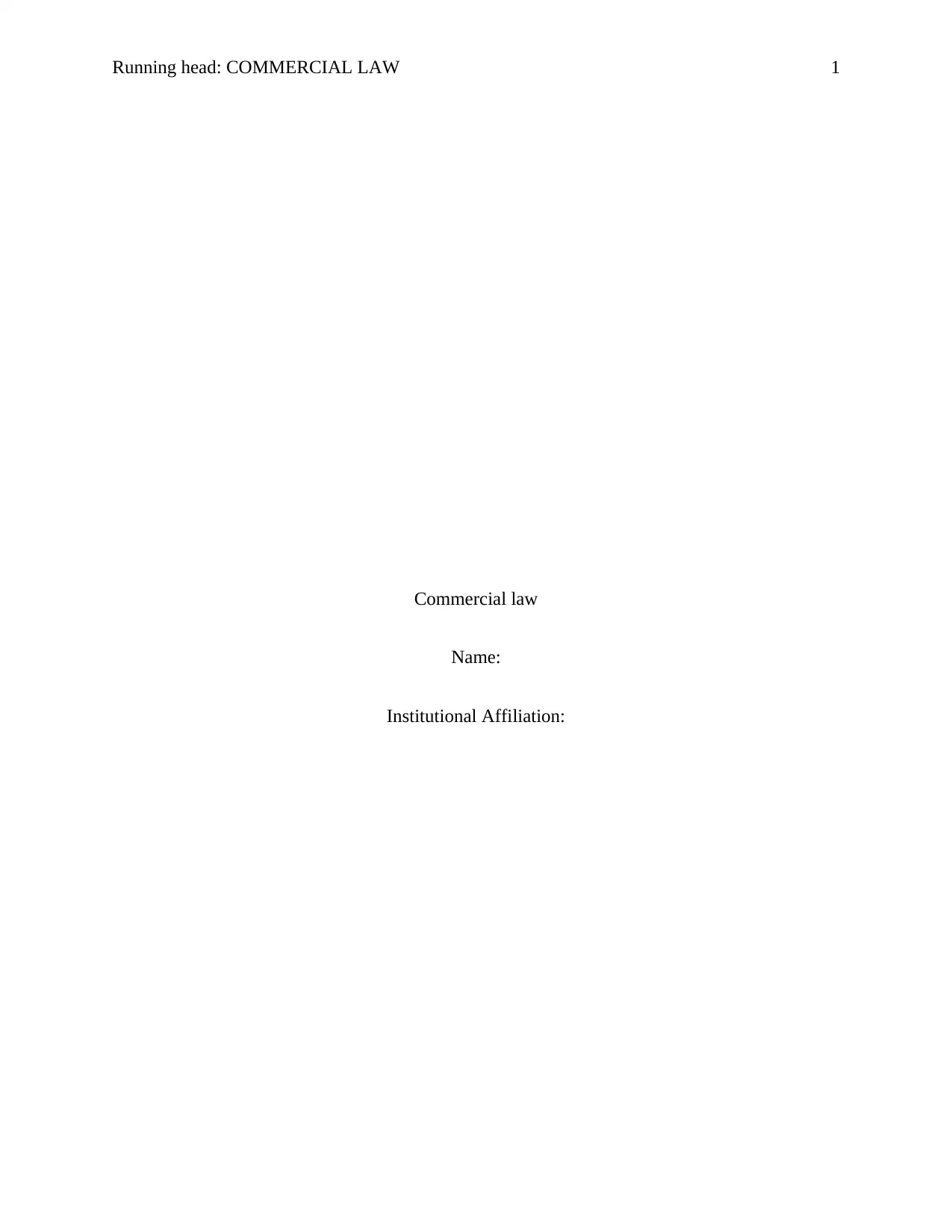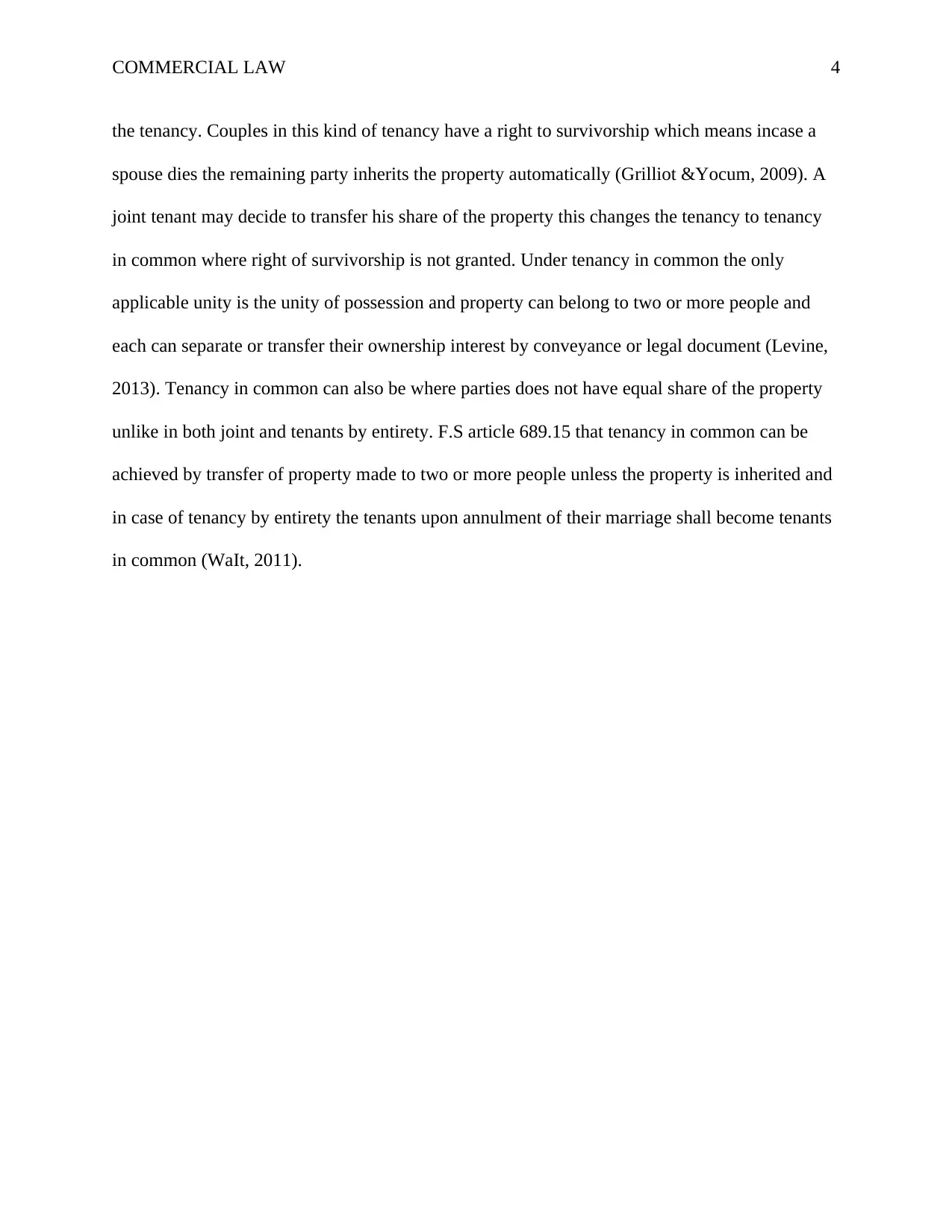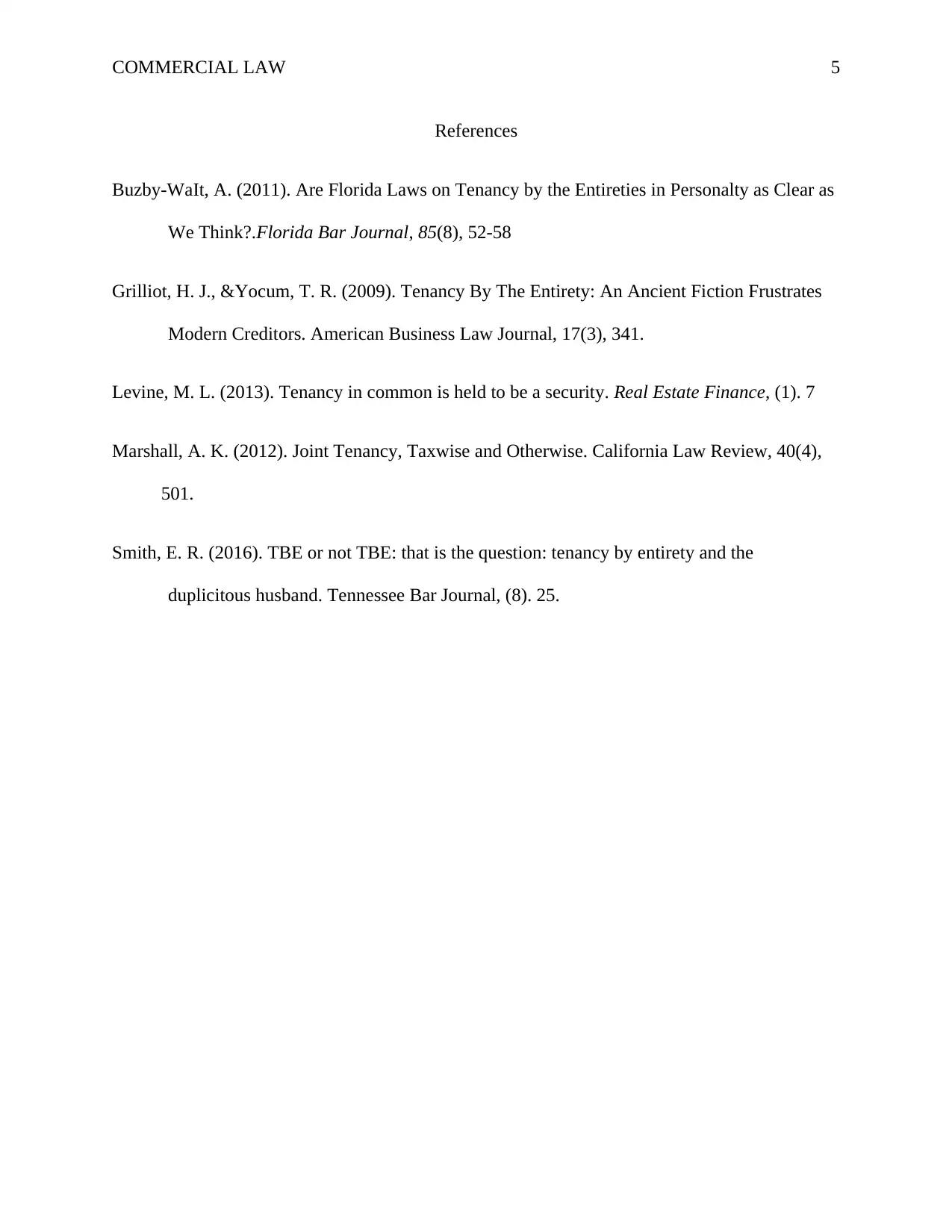Commercial Law Assignment: Tenancy by Entirety Case Study Analysis
VerifiedAdded on 2020/04/21
|5
|989
|118
Case Study
AI Summary
This case study analyzes a commercial law case concerning tenancy by entirety, a legal concept allowing married couples to jointly own property. The court's decision affirmed the presumption of jointly owned assets as tenancy by entirety, emphasizing the six unities: possession, interest, title, time, survivorship, and marriage. The analysis explores how this form of ownership impacts creditor rights, specifically highlighting that only creditors of both parties can seize the property. The document differentiates tenancy by entirety from joint tenancy and tenancy in common, outlining the implications of each form of ownership, including survivorship rights and the ability to transfer shares. The analysis references relevant legal articles and case law to support its conclusions.

Running head: COMMERCIAL LAW 1
Commercial law
Name:
Institutional Affiliation:
Commercial law
Name:
Institutional Affiliation:
Paraphrase This Document
Need a fresh take? Get an instant paraphrase of this document with our AI Paraphraser

COMMERCIAL LAW 2
Commercial law
The Court’s Decision
The tenancy by entirety is a law that allows married couple to jointly own property; it
means that each couple owns the whole property and not a part of it, this can also be referred to
as holding “per tout” therefore no spouse owns the property individually this law is guided by 6
by-laws known as unities (Buzby-WaIt, 2011):
a) Unity of possession which allows couple to jointly own and control the property.
b) Unity of interest which requires the property to have identical interests.
c) Under unity of title the interest must come from the same implementation.
d) Unity of time requires the interest to have begun simultaneously.
e) Survivorship means in case one spouse dies the property rights is transferred to
the surviving partner and this cannot be overruled by one spouse transferring or
selling their shares.
f) Finally the parties must be married to when they acquired the property.
The court analyzed all unities and affirmed that indeed presumption of jointly owned
assets being regarded as tenancy by entirety since the couple were married and together owned
the restaurant, the building in which the business was located and the account in which proceeds
from the business used to go to for 43 years, all the conditions were met as required by law hence
the judge was right in ruling in favor of the husband (Smith, 2016).
When tenancy by entirety is presumed, only the creditors of both parties can seize the
property in case of default in payment because the property cannot be divided on behalf of one
Commercial law
The Court’s Decision
The tenancy by entirety is a law that allows married couple to jointly own property; it
means that each couple owns the whole property and not a part of it, this can also be referred to
as holding “per tout” therefore no spouse owns the property individually this law is guided by 6
by-laws known as unities (Buzby-WaIt, 2011):
a) Unity of possession which allows couple to jointly own and control the property.
b) Unity of interest which requires the property to have identical interests.
c) Under unity of title the interest must come from the same implementation.
d) Unity of time requires the interest to have begun simultaneously.
e) Survivorship means in case one spouse dies the property rights is transferred to
the surviving partner and this cannot be overruled by one spouse transferring or
selling their shares.
f) Finally the parties must be married to when they acquired the property.
The court analyzed all unities and affirmed that indeed presumption of jointly owned
assets being regarded as tenancy by entirety since the couple were married and together owned
the restaurant, the building in which the business was located and the account in which proceeds
from the business used to go to for 43 years, all the conditions were met as required by law hence
the judge was right in ruling in favor of the husband (Smith, 2016).
When tenancy by entirety is presumed, only the creditors of both parties can seize the
property in case of default in payment because the property cannot be divided on behalf of one

COMMERCIAL LAW 3
partner alone and therefore cannot be used to recover an individual’s debt. The joint bank
account used by Barnes could not be used by the bank to pay off the debts of the husband since
the account was held in entirety. As stated in F.S article 90.304, a bank account owned by both
partners is presumed to be tenancy by entirety if both spouses adhered to unities of possession,
interest, title and time (Buzby-WaIt, 2011). Thus, the creditor should be able to show that a
tenancy by entirety was not created in order to recover debt from the couple. The bank failed to
prove that although the account was jointly owned by the Barnes, the couples did not specify as
to the kind of ownership. Otherwise, the bank was supposed to insist on both spouses
guaranteeing clearing the debt to avoid the presumption of the tenancy.
Husband’s Name on Documents
The defendant always consulted with his wife before making decision which means for
the husband to have some documents bearing his name only was an amicable decision by the two
and not an act of separation of assets or part of it, but sole ownership can be achieved when one
spouse transfers their right to interest of the property by conveyance or by deed (WaIt, 2011).
Unity of possession does not prevent from acting on behalf of the other when account is
owned by both of them provided the consent is given by the other partner.
Holding of Property
Joint tenancy every individual has a separate but equal share to property “per my’ with
their partner and incase of separation each gets half of the shared assets (Marshall, 2012). In joint
tenancy own property may be created by an oral agreement and any party in joint tenancy can
decide to bring to an end the tenancy by voluntarily agreeing to divide or independently ending
partner alone and therefore cannot be used to recover an individual’s debt. The joint bank
account used by Barnes could not be used by the bank to pay off the debts of the husband since
the account was held in entirety. As stated in F.S article 90.304, a bank account owned by both
partners is presumed to be tenancy by entirety if both spouses adhered to unities of possession,
interest, title and time (Buzby-WaIt, 2011). Thus, the creditor should be able to show that a
tenancy by entirety was not created in order to recover debt from the couple. The bank failed to
prove that although the account was jointly owned by the Barnes, the couples did not specify as
to the kind of ownership. Otherwise, the bank was supposed to insist on both spouses
guaranteeing clearing the debt to avoid the presumption of the tenancy.
Husband’s Name on Documents
The defendant always consulted with his wife before making decision which means for
the husband to have some documents bearing his name only was an amicable decision by the two
and not an act of separation of assets or part of it, but sole ownership can be achieved when one
spouse transfers their right to interest of the property by conveyance or by deed (WaIt, 2011).
Unity of possession does not prevent from acting on behalf of the other when account is
owned by both of them provided the consent is given by the other partner.
Holding of Property
Joint tenancy every individual has a separate but equal share to property “per my’ with
their partner and incase of separation each gets half of the shared assets (Marshall, 2012). In joint
tenancy own property may be created by an oral agreement and any party in joint tenancy can
decide to bring to an end the tenancy by voluntarily agreeing to divide or independently ending
⊘ This is a preview!⊘
Do you want full access?
Subscribe today to unlock all pages.

Trusted by 1+ million students worldwide

COMMERCIAL LAW 4
the tenancy. Couples in this kind of tenancy have a right to survivorship which means incase a
spouse dies the remaining party inherits the property automatically (Grilliot &Yocum, 2009). A
joint tenant may decide to transfer his share of the property this changes the tenancy to tenancy
in common where right of survivorship is not granted. Under tenancy in common the only
applicable unity is the unity of possession and property can belong to two or more people and
each can separate or transfer their ownership interest by conveyance or legal document (Levine,
2013). Tenancy in common can also be where parties does not have equal share of the property
unlike in both joint and tenants by entirety. F.S article 689.15 that tenancy in common can be
achieved by transfer of property made to two or more people unless the property is inherited and
in case of tenancy by entirety the tenants upon annulment of their marriage shall become tenants
in common (WaIt, 2011).
the tenancy. Couples in this kind of tenancy have a right to survivorship which means incase a
spouse dies the remaining party inherits the property automatically (Grilliot &Yocum, 2009). A
joint tenant may decide to transfer his share of the property this changes the tenancy to tenancy
in common where right of survivorship is not granted. Under tenancy in common the only
applicable unity is the unity of possession and property can belong to two or more people and
each can separate or transfer their ownership interest by conveyance or legal document (Levine,
2013). Tenancy in common can also be where parties does not have equal share of the property
unlike in both joint and tenants by entirety. F.S article 689.15 that tenancy in common can be
achieved by transfer of property made to two or more people unless the property is inherited and
in case of tenancy by entirety the tenants upon annulment of their marriage shall become tenants
in common (WaIt, 2011).
Paraphrase This Document
Need a fresh take? Get an instant paraphrase of this document with our AI Paraphraser

COMMERCIAL LAW 5
References
Buzby-WaIt, A. (2011). Are Florida Laws on Tenancy by the Entireties in Personalty as Clear as
We Think?.Florida Bar Journal, 85(8), 52-58
Grilliot, H. J., &Yocum, T. R. (2009). Tenancy By The Entirety: An Ancient Fiction Frustrates
Modern Creditors. American Business Law Journal, 17(3), 341.
Levine, M. L. (2013). Tenancy in common is held to be a security. Real Estate Finance, (1). 7
Marshall, A. K. (2012). Joint Tenancy, Taxwise and Otherwise. California Law Review, 40(4),
501.
Smith, E. R. (2016). TBE or not TBE: that is the question: tenancy by entirety and the
duplicitous husband. Tennessee Bar Journal, (8). 25.
References
Buzby-WaIt, A. (2011). Are Florida Laws on Tenancy by the Entireties in Personalty as Clear as
We Think?.Florida Bar Journal, 85(8), 52-58
Grilliot, H. J., &Yocum, T. R. (2009). Tenancy By The Entirety: An Ancient Fiction Frustrates
Modern Creditors. American Business Law Journal, 17(3), 341.
Levine, M. L. (2013). Tenancy in common is held to be a security. Real Estate Finance, (1). 7
Marshall, A. K. (2012). Joint Tenancy, Taxwise and Otherwise. California Law Review, 40(4),
501.
Smith, E. R. (2016). TBE or not TBE: that is the question: tenancy by entirety and the
duplicitous husband. Tennessee Bar Journal, (8). 25.
1 out of 5
Your All-in-One AI-Powered Toolkit for Academic Success.
+13062052269
info@desklib.com
Available 24*7 on WhatsApp / Email
![[object Object]](/_next/static/media/star-bottom.7253800d.svg)
Unlock your academic potential
Copyright © 2020–2025 A2Z Services. All Rights Reserved. Developed and managed by ZUCOL.